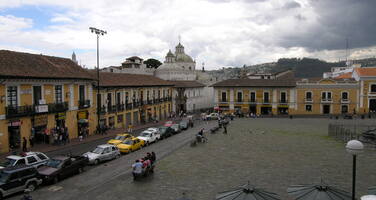City of Quito
Factors affecting the property in 1990*
- Earthquake
- Effects arising from use of transportation infrastructure
- Identity, social cohesion, changes in local population and community
UNESCO Extra-Budgetary Funds until 1990
UNDP released $130,000 for the work to be undertaken on San Augustin and El Sagrario
Several feasibility studies were outlined during a seminar for which international financing has been identified (UNDP/IDB) concerning:
(i) the development and management of tourism in the historic centre of Quito ($160,000), on the understanding that tourism remains compatible with the master plan;
(ii) the urban rehabilitation of the historic centre ($250,000);
(iii) strengthening of the municipality's planning service ($150,000).
International Assistance: requests for the property until 1990
Total amount approved : 192,000 USD
| 1989 | Expert mission to elaborate a conservation plan for the ... (Approved) | 15,000 USD |
| 1988 | Financial assistance to enable an architect from Quito ... (Approved) | 7,000 USD |
| 1987 | Urgent work required for the consolidation of Quito's ... (Approved) | 70,000 USD |
| 1987 | Financial assistance to the urgent works required for ... (Approved) | 30,000 USD |
| 1987 | Financial assistance to pursue the preservation works ... (Approved) | 10,000 USD |
| 1984 | Financial contribution for the restoration of the ... (Approved) | 10,000 USD |
| 1981 | Equipment and consultants for restoration of Quito - ... (Approved) | 25,000 USD |
| 1981 | Equipment and consultants for restoration of Quito (Approved) | 25,000 USD |
Missions to the property until 1990**
November 1988: expert mission
Conservation issues presented to the World Heritage Committee in 1990
This site, placed on the World Heritage List in 1978 under criteria (ii) and (iv), was very affected by the earthquake that occurred in March 1987.
Thanks to emergency assistance amounting to US $30,000 from the World Heritage Fund, an expert carried out an on-the-spot mission in November 1988 to assist the national and local authorities in assessing the damage caused by the earthquake and ascertaining what restoration and consolidation work was urgently required, particularly on the churches and monasteries of Santa Clara, San Augustin, Santo Domingo, El Tejar, Guapulo, El Sagrario and San Francisco. The mission enabled the total cost of the work to restore the Quito monuments to be set at about $6,000,000.
At its eleventh session the World Heritage Committee approved additional emergency assistance in an amount of $70,000 for the most urgent consolidation operations.
At the same time, UNDP released $130,000 for the work to be undertaken on San Augustin and El Sagrario, the World Heritage Fund allocation being intended to be used for the restoration of the convent of Santa Clara and the churches of Santo Domingo and Guapulo.
At the present time several restoration operations are in progress, under the responsibility of various institutions. The National Cultural Heritage Institute (INPC) is in charge of the restoration of El Sagrario, Santo Domingo, San Augustin, Santa Clara, San Francisco and Guapulo. The Central Bank of Ecuador has assumed responsibility for the Merced, the 'Compania de Jesus', the Municipality of Quito, the cathedral and various parish churches in the historic centre. All the restoration work is being carried out in close conjunction with the UNDP/Unesco project (ECU/88/001) 'Restoration of the historic monuments affected by the March 1987 earthquake'. Other work is also being carried out with the help of funds resulting from bilateral co-operation (Italy, Spain, Belgium).
In 1989 the Chairman of the World Heritage Committee approved $15,000 for the organization of a seminar on the rehabilitation of the historic centre of Quito. The fact is that, in addition to isolated restoration operations, a coherent rehabilitation plan is needed, the historic centre of Quito being subjected to the adverse effects of overpopulation and heavy traffic. The principal expert assigned to the UNDP/Unesco regional project for the safeguarding and development of the cultural heritage in Latin America helped to organize the seminar whose purpose was to:
(i) work out a comprehensive strategy for short- and medium-term rehabilitation;
(ii) draw up a technical and financial assistance programme to be submitted to international sponsors;
(iii) work out an institutional framework; and
(iv) give an opinion regarding the plan proposed by the Municipality of Quito, the identification of the funds required and their management.
The conclusions of the seminar highlight the problem that will be entailed by the financing of conservation and socio-economic rehabilitation projects. The establishment in 1987 of a Safeguarding Fund (FONSAL), the setting up in 1988 of the Caspicara Foundation (Ecuadorian foundation for the dissemination of the country's historical and cultural values) and the decision to prepare a master plan were considered to be means of attracting public or private international funds.
Several feasibility studies were outlined during the seminar for which international financing has been identified (UNDP/IDB) concerning:
(i) the development and management of tourism in the historic centre of Quito ($160,000), on the understanding that tourism remains compatible with the master plan;
(ii) the urban rehabilitation of the historic centre ($250,000);
(iii) strengthening of the municipality's planning service ($150,000).
Summary of the interventions
Decisions adopted by the Committee in 1990
No draft Decision
* :
The threats indicated are listed in alphabetical order; their order does not constitute a classification according to the importance of their impact on the property.
Furthermore, they are presented irrespective of the type of threat faced by the property, i.e. with specific and proven imminent danger (“ascertained danger”) or with threats which could have deleterious effects on the property’s Outstanding Universal Value (“potential danger”).
** : All mission reports are not always available electronically.


